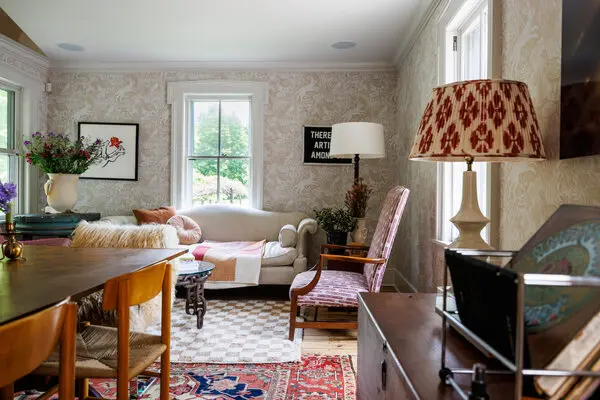When it comes to interior design, layering is an essential technique that can turn any room from plain to polished. Whether you’re decorating a cozy living room, a spacious bedroom, or even a kitchen, the right combination of rugs, cushions, and curtains can create depth, comfort, and a cohesive look. These soft furnishings play a vital role in transforming your space, and mastering the art of layering them will allow you to achieve a professionally designed aesthetic without breaking the bank. Let’s explore how you can combine these elements like a pro.
Understanding the Power of Layering
Layering in interior design refers to the process of using multiple design elements, such as textures, colors, and materials, to create visual depth and interest. When done right, layering can make a space feel more inviting, dynamic, and balanced. Soft furnishings—such as rugs, cushions, and curtains—are perfect for layering because they offer flexibility and comfort, all while enhancing the room’s overall style.
By adding layers of different textures and colors, you can create a visually appealing and cozy environment that feels curated and thoughtfully designed. Let’s dive into how you can incorporate each of these soft furnishings to master the layering technique.
Rugs: The Foundation of Layering
Rugs are one of the easiest and most impactful ways to start layering your space. A well-chosen rug can anchor the entire room and bring your other decor elements together. The right rug can define different zones within a room, such as a living area or dining space, while also adding warmth and comfort underfoot.
Start by selecting a rug that complements the size and shape of your room. In larger rooms, you may want to go for a bigger rug that fits underneath the front legs of your furniture to tie the space together. In smaller rooms, a smaller rug can define a particular area, such as a reading nook or seating arrangement.
When layering rugs, consider texture and pattern. A plush shag rug, for example, can add depth to a minimalist room, while a jute rug can bring an earthy, natural feel. For added visual interest, don’t be afraid to mix patterns, such as a geometric rug paired with a floral throw or a solid-color rug combined with bold cushion covers.
Cushions: Adding Comfort and Style
Cushions are the unsung heroes of home decor. Not only do they provide comfort, but they also act as accent pieces that bring personality to your space. Layering cushions in different sizes, shapes, and textures can create a cozy and inviting atmosphere, while also complementing your rug and curtains.
To layer cushions effectively, mix and match different sizes. For example, start with larger cushions as the base (such as 20-inch cushions) and then add smaller cushions (12 or 16 inches) on top for a layered look. Varying the shapes—square, rectangular, and even round cushions—adds visual interest and dimension.
The fabric and texture of your cushions are equally important. Consider using a combination of materials, such as velvet, linen, cotton, and faux fur. Velvet cushions will add a luxurious touch, while cotton and linen cushions can create a more relaxed and casual vibe. Don’t hesitate to play with color, either—use bold, contrasting tones for a dramatic look or soft, neutral shades for a more understated style.
Curtains: Elevating the Space with Elegance
Curtains are more than just functional window coverings—they’re a powerful design element that can elevate any room. When layered with rugs and cushions, curtains help frame the room and create a sense of height and space. The right curtains can add softness and flow to a room, making it feel complete and balanced.
When layering curtains, consider the fabric. Lighter materials like linen and cotton will provide a breezy, airy feel, while heavier fabrics such as velvet or wool can create a more luxurious, cozy atmosphere. Layering different curtain types—like sheer curtains behind thicker blackout curtains—can give you both privacy and a soft, filtered light during the day.
To achieve a professionally designed look, opt for floor-to-ceiling curtains that create a sense of height and openness in your room. For added drama, choose curtains in bold colors or rich textures that complement the colors and patterns in your rugs and cushions.
Color Coordination: Creating Harmony Across Layers
One of the most important elements of mastering the art of layering is color coordination. While it’s tempting to use a wide variety of colors, a cohesive palette will give your space a more polished and intentional feel. The key to successful layering is ensuring that each element—your rug, cushions, and curtains—works harmoniously together.
Start with a base color for your room, such as neutral tones like beige, gray, or white. These shades provide a versatile foundation that allows you to play with accent colors through your soft furnishings. When selecting cushions, rugs, and curtains, make sure that their colors either complement or contrast in a balanced way. For example, if your rug has earthy tones, your cushions can introduce a pop of color, such as mustard yellow or teal, while your curtains may opt for a soft neutral that lets the other elements shine.
Don’t forget about the power of pattern. When mixing patterns, try to incorporate different scales and styles to avoid overwhelming the space. A bold geometric rug can be paired with solid-color cushions and patterned curtains to create a dynamic yet cohesive look.
Mixing Textures: Adding Depth and Visual Interest
Textures are the secret ingredient that brings layering to life. By mixing different textures, you can add depth and visual intrigue to your space. For instance, combining the softness of a plush velvet cushion with the roughness of a jute rug creates a contrast that is both sophisticated and inviting.
Textures also affect the overall ambiance of the room. Velvet and silk add luxury and glamour, while linen and cotton give a relaxed, natural vibe. Wool, leather, and faux fur can bring warmth and comfort. When layering your soft furnishings, try to combine different textures in each element—perhaps a wool rug with velvet cushions and linen curtains—to create a sense of balance and harmony.
Seasonal Layering: Refreshing Your Decor Year-Round
Another great benefit of mastering layering with rugs, cushions, and curtains is that you can easily update your space for different seasons. For example, swap out heavy wool throws for lighter cotton ones in the spring, or replace bright, floral cushions with more autumnal colors in the fall. Changing your soft furnishings seasonally is an affordable way to keep your home feeling fresh without having to completely overhaul your decor.
In the summer, you can go for lighter textures and breezy colors, while in winter, richer textures like velvet or faux fur can create a cozy, inviting atmosphere. Adjusting your soft furnishings in response to the seasons helps you maintain a dynamic, comfortable living space year-round.
Conclusion
Layering rugs, cushions, and curtains is a simple yet effective way to transform your space. By combining textures, colors, and materials thoughtfully, you can create a cozy, chic, and visually appealing room that feels cohesive and well-designed. Whether you’re aiming for a relaxed, casual vibe or a sophisticated, elegant atmosphere, mastering the art of layering these soft furnishings will help you achieve your ideal space. With a little creativity and attention to detail, you can decorate your home like a pro and enjoy a space that’s both stylish and inviting.




